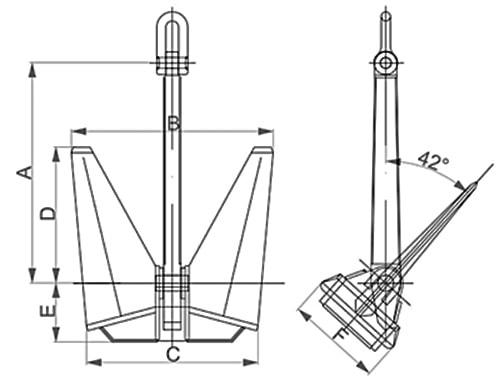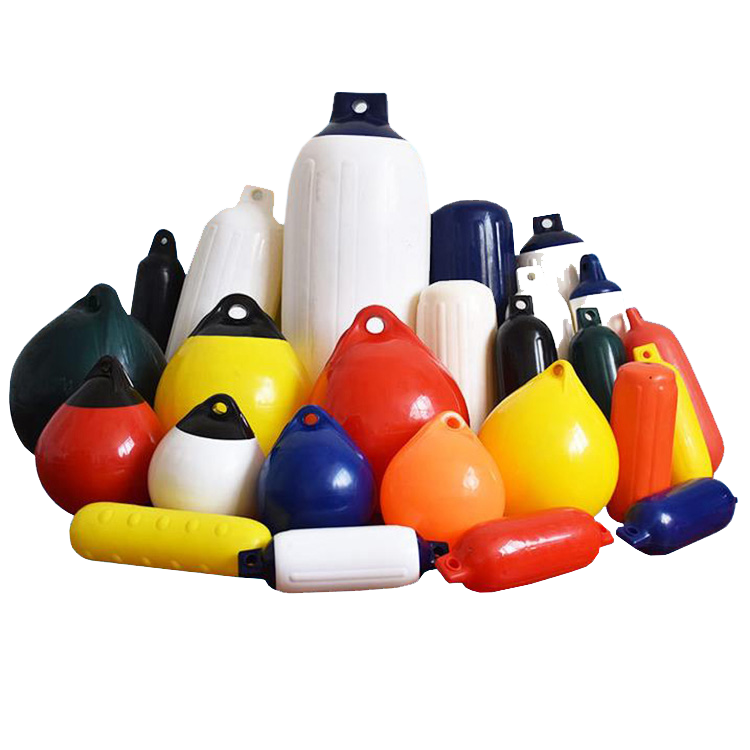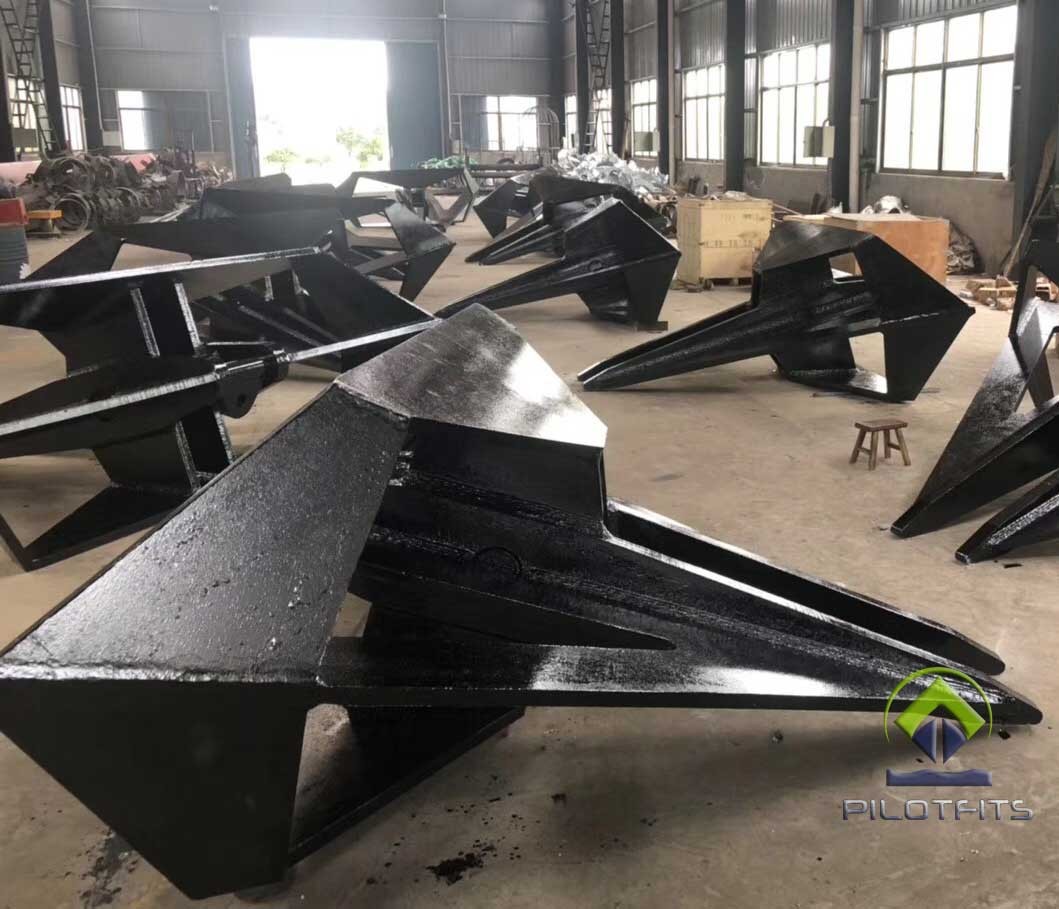Project Description
HHP POOL N TYPE ANCHOR

HHP N Type Pool Anchor: Fully Balanced vs. Unbalanced
The HHP N Type Pool Anchor comes in both Fully Balanced and Unbalanced options, designed to fit seamlessly into small anchor pockets.
Fully Balanced Anchors offer even load distribution for enhanced stability and safety, making them ideal for demanding installations. In contrast, Unbalanced Anchors are suitable for lighter applications or temporary setups.
Product Details:
- High Holding Power Anchor
- Material: ZG230-45CH, Q345C, stainless steel 316L
- Weight: 50kg to 20000kg
- Finishing: black painting, hot dip galvanized
- Certificate: BV, ABS, DNV,GL, LRS, RINA, RS, IRS, CCS, KR, NK


| Nominal Weight(kg) | A | B | C | D | E | F |
|---|---|---|---|---|---|---|
| 60 | 590 | 555 | 470 | 364 | 157 | 270 |
| 80 | 664 | 605 | 515 | 410 | 176 | 295 |
| 100 | 712 | 655 | 555 | 440 | 190 | 320 |
| 160 | 835 | 765 | 650 | 516 | 223 | 370 |
| 200 | 885 | 825 | 700 | 546 | 236 | 400 |
| 280 | 1008 | 925 | 780 | 622 | 269 | 450 |
| 360 | 1096 | 1005 | 855 | 677 | 292 | 490 |
| 480 | 1186 | 1105 | 940 | 728 | 314 | 535 |
| 600 | 1300 | 1190 | 1010 | 802 | 347 | 580 |
| 765 | 1410 | 1290 | 1096 | 870 | 375 | 610 |
| 1000 | 1526 | 1395 | 1185 | 942 | 404 | 660 |
| 1080 | 1580 | 1446 | 1230 | 975 | 421 | 685 |
| 1195 | 1636 | 1485 | 1270 | 1010 | 436 | 708 |
| 1305 | 1680 | 1541 | 1308 | 1037 | 448 | 730 |
| 1440 | 1738 | 1592 | 1352 | 1073 | 464 | 754 |
| 1575 | 1769 | 1640 | 1386 | 1092 | 472 | 777 |
| 1710 | 1840 | 1686 | 1455 | 1137 | 491 | 798 |
| 1845 | 1890 | 1729 | 1469 | 1168 | 504 | 819 |
| 1980 | 1935 | 1770 | 1504 | 1195 | 516 | 836 |
| 2140 | 1986 | 1816 | 1543 | 1226 | 530 | 860 |
| 2295 | 2030 | 1860 | 1580 | 1254 | 540 | 880 |
| 2655 | 2140 | 1954 | 1684 | 1322 | 566 | 926 |
| 2835 | 2188 | 1996 | 1700 | 1351 | 580 | 945 |
| 3000 | 2238 | 2042 | 1736 | 1382 | 592 | 968 |
| 3240 | 2287 | 2086 | 1773 | 1412 | 605 | 988 |
| 3940 | 2442 | 2226 | 1892 | 1508 | 646 | 1055 |
| 4500 | 2553 | 2328 | 1976 | 1567 | 675 | 1103 |
| 5175 | 2675 | 2439 | 2072 | 1651 | 708 | 1155 |
| 5515 | 2730 | 2491 | 2116 | 1686 | 722 | 1180 |
| 5850 | 2786 | 2541 | 2159 | 1720 | 737 | 1204 |
| 6225 | 2838 | 2594 | 2204 | 1750 | 756 | 1229 |
| 6525 | 2880 | 2635 | 2239 | 1780 | 768 | 1248 |
| 6975 | 2948 | 2695 | 2290 | 1820 | 786 | 1276 |
| 7425 | 3010 | 2760 | 2338 | 1858 | 802 | 1303 |
| 7875 | 3069 | 2805 | 2384 | 1895 | 818 | 1329 |
| 8775 | 3180 | 2908 | 2471 | 1964 | 848 | 1376 |
| 9225 | 3235 | 2968 | 2512 | 1997 | 862 | 1401 |
| 9675 | 3286 | 3004 | 2553 | 2029 | 876 | 1423 |
| 10125 | 3337 | 3060 | 2592 | 2060 | 890 | 1445 |
| 10575 | 3386 | 3095 | 2630 | 2090 | 902 | 1468 |
| 12075 | 3538 | 3236 | 2748 | 2184 | 943 | 1533 |
| 12675 | 3596 | 3288 | 2794 | 2220 | 958 | 1556 |
| 13350 | 3658 | 3346 | 2842 | 2258 | 975 | 1585 |
| 14100 | 3726 | 3406 | 2894 | 2300 | 993 | 1614 |
| 15000 | 3804 | 3476 | 2954 | 2348 | 1014 | 1646 |
| 17250 | 3985 | 3643 | 3095 | 2460 | 1062 | 1726 |
| 20825 | 4240 | 3887 | 3285 | 2618 | 1130 | 1832 |
| 24750 | 4495 | 4109 | 3491 | 2775 | 1198 | 1947 |
| 28875 | 4717 | 4324 | 3675 | 2912 | 1258 | 2049 |
Fully Balanced vs. Unbalanced Type Anchors: Key Differences Explained
- When it comes to anchoring systems, understanding the difference between fully balanced and unbalanced type anchors is crucial for your project’s success.
- Fully Balanced Anchors are designed to distribute loads evenly across their structure. This balanced load distribution enhances stability and minimizes stress on surrounding materials, making them an excellent choice for high-stress applications such as bridges, tall buildings, and heavy machinery installations. Their reliability ensures safety and longevity, which is critical in engineering projects.
- Unbalanced Anchors do not distribute loads as evenly. This can lead to increased stress on certain points, potentially compromising the integrity of the structure over time. While unbalanced anchors may be suitable for lighter applications or temporary setups, they are generally not recommended for projects where safety and durability are paramount.
Choosing the right anchor type is essential for maximizing performance and ensuring the safety of your construction. Always consider your project’s specific requirements before making a decision.





